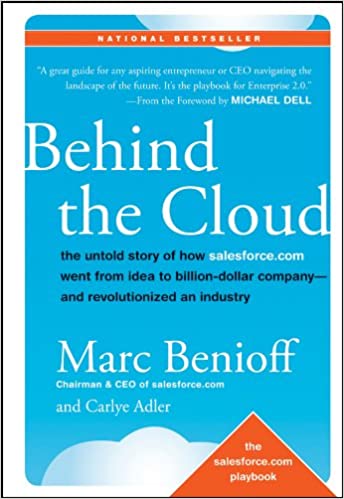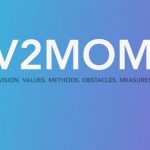Print | Kindle(eBook) | Audiobook
Behind the Cloud is a great account of how Marc Benioff revolutionalized the software industry and pioneered cloud computing with his company salesforce.com. He shares 111 strategies, he used to build the company with the help of very talented individuals and partners.
Marc tells how he and his team created and used new business, technology, and philanthropic models tailored to this time of extraordinary change. Showing how salesforce.com not only survived the dotcom implosion of 2001, but went on to define itself as the leader of the cloud computing revolution and spark a $46-billion dollar industry,
“Seize the opportunity in front of you. Imagine. Invent. Disrupt. Do good. I know that you must be passionate, unreasonable, and a little bit crazy to follow your own ideas and do things differently. But it’s worth it. Life grows relative to one’s investment in it. I promise you that by considering everyone’s success, you will see the return.”
Here are my favorite takeaways from reading, Behind the Cloud by Marc Benioff:
Salesforce.com sought to solve similar inefficiencies in the software industry. Enterprise software was exorbitantly expensive and onerous to implement, and, in the end, it didn’t work very well. This was what enterprise customers came to expect. Marc changed that reality when he used the Internet as a platform to deliver business software and reduce the risks and costs long associated with the client-server model. Saleforce.com made its service available to the masses, and it attentively and creatively engaged with its entire audience.
The Idea
“I started salesforce.com in a rented apartment in 1999 with the goal of making enterprise software as easy to use as a Web site like Amazon.com. That idea—to deliver business applications as a service over the Internet—would change the way businesses use sophisticated software applications and, ultimately, change the way the software industry works. In less than a decade, our business has grown from a simple idea to a public company with more than a billion dollars in revenue.”
Summer Job at Apple
“In 1984, I had a summer job at Apple writing some of the first native assembly language for the Macintosh. I had the opportunity to work on the most exciting and important project at Apple, and it was like getting paid to go to Disneyland. There were fruit smoothies in the refrigerators, a motorcycle in the lobby, and shiatsu massages.”
Lesson from Apple
“My summers at Apple had taught me that the secret to encouraging creativity and producing the best possible product was to keep people fulfilled and happy. I wanted the people who built salesforce.com to be inspired and to feel valued.”
Sabbatical
“My sabbatical was one of the most productive periods of my career; it was certainly one of the most influential. Don’t be afraid to take time off when you need it. You could learn something that will change the course of your life, and at the least you will stave off the burnout that plagues so many driven, entrepreneurial people”
80/20 percent rule
“Our focus was directed at developing the best possible and easiest to use product, and this is where we invested our time. Realize that you won’t be able to bring the same focus to everything in the beginning. There won’t be enough people or enough hours in the day. So focus on the 20 percent that makes 80 percent of the difference.”
Play #10: Defy Convention
Don’t be afraid to ignore rules of your industry that have become obsolete or that defy common sense. Creating an attractive user interface that people enjoy using is the key to building a truly great product. This seems so obvious, but it wasn’t the way in which software design was customarily approached.
Transiency
“There is a Japanese belief that business is temporal, whereas relationships are eternal. That’s true. One day you compete. The next day you partner. One day someone is your subordinate; the next day he or she may be your superior. At its finest, business is friendly competition, just like a game of tennis.”
Clarity of Mind
“Don’t ever let the competition make you angry. You must have clarity of mind to make your own decisions—not the ones that your competitors want you to make. You must be transparent to the competition. See, recognize, and understand what your competitor is doing.”
Being small, nimble, and in constant communication with our earliest customers is what enabled us to produce a terrific service.
Go from Adoption to Addiction with a Feedback Loop
Be open to including all customers, and treat them as partners. To do so, utilize a fast and prioritized “feedback loop:
1. Stay in touch with customers.
2. Develop a way to track their requests.
3. Respond to their requests quickly.
4. Ask if their needs have been satisfactorily met.
5. Pay attention to how they are using the product.
Selsmanship
“Nine times out of ten, companies fail because they don’t set up a large enough sales force and thus have no way to collect enough revenue. Don’t skimp on sales reps: 25 to 50 percent of the employee base should be salespeople who report to the head of sales. (Half of our company is in sales.)”
“When you are in a growth phase, use cash to hire—and hire, hire, hire! You have to grow the distribution capacity by having as many salespeople as you can and by organizing and managing the sales team to ensure productivity. At the same time, it’s necessary to motivate individuals to close as much business as possible.”
Companies must not only see innovation before it is obvious to the market but also have the courage to pursue that innovation years before it’s accepted, or even understood.
Right Partnerships
“The secret to building winning technology was not only that we bet on the right building blocks but also that our vendors’ executives were personally committed to our success. Today, more than ever before, companies do not need to build technology from scratch; you can build on Internet-based platforms and tap into distribution centers, data centers, and unlimited computing power. The cloud computing model saves time and capital. All companies benefit when they can afford to focus on innovation rather than infrastructure.”
“ In the U.S., entrepreneurs provide on average about two-thirds of startup capital and after that look to family, friends, work colleagues, and strangers—not venture capital firms—to provide the remainder of the investment capital.“(Of that group, research shows that family and friends provide 78 percent of the total.)“
Play #99: Allow for Change as Your Company Grows
“At each level of growth, adjustments are required; it’s the natural process of maturing. That said, growing up isn’t always easy, and it’s not always fun. It can be tough for a fast-moving entrepreneurial culture to adopt more structure, but bringing outside talent into the organization can make it easier to see what changes are necessary to ensure a smooth transition.”
V2MOM (Vision, Values, Methods, Obstacles, and Measures).
“V2MOM enabled me to clarify what I was doing and communicate it to the entire company as well.” The vision helped us define what we wanted to do.
- The values established what was most important about that vision; it set the principles and beliefs that guided it (in priority).
- The methods illustrated how we would get the job done by outlining the actions and the steps that everyone needed to take.
- The obstacles identified the challenges, problems, and issues we would have to overcome to achieve our vision.
- Finally, the measures specified the actual result we aimed to achieve; often this was defined as a numerical outcome. Combined, V2MOM gave us a detailed map of where we were going as well as a compass to direct us there.
“Essentially, V2MOM is an exercise in awareness in which the result is total alignment. In addition, having a clarified direction and focusing collective energy on the desired outcome eliminate the anxiety that is often present in times of change.”
Brand Messaging
“Brands are built and sustained on consistency. Whether employees realize it or not, everyone in a company interfaces with customers in one way or another, and their attitude will affect the brand. A wrong message or attitude from one person has the potential to dilute our brand, so we try to make sure everyone is in alignment from the beginning.”
Play #108: Challenge Your Best People with New Opportunities
“The very best and brightest people can quickly overcome challenges and be ready for the next step. It’s imperative to offer them new opportunities to keep them engaged and firmly committed. As much as it’s necessary to define initial job positions, it’s equally imperative to allow the individual to stretch in new directions.”
“One of the best ways to keep employees engaged is to evolve positions frequently. (This is not simply in the context of dealing with someone who is not working out. It should go without saying that you would remove those people as quickly as possible.) Take the people who are dynamite in their posts and move them somewhere else. They will appreciate the new challenges, and a stale spot in your organization will be reenergized, or a new area can get off the ground.”
“The storm is the time to fish.” – Eskimo Proverb
We weren’t always aware of it, but we were guided by his three rules of work:
1) Out of clutter find simplicity;
2) From discord find harmony;
3) In the middle of difficulty lies opportunity.
All the best in your quest to get better. Don’t Settle: Live with Passion,



1 Comment
Pingback: 100 Books Reading Challenge 2021 – Lanre Dahunsi